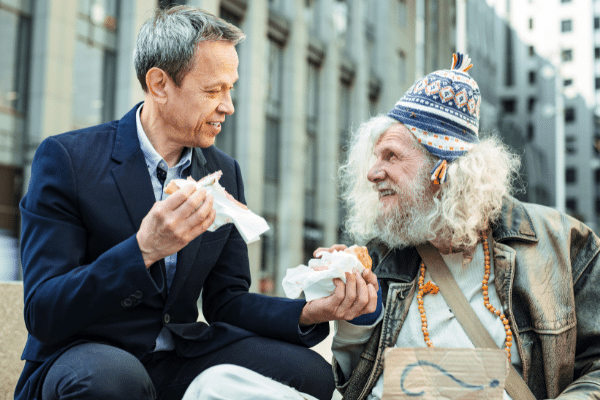Spontaneous Serving

A pastor friend told this story this week in his weekly column. On Saturday, I stopped by a fast-food restaurant for a sweet tea. I opted to go in the restaurant instead of the drive-thru. There were a few other people in front of me, including a man who looked pretty ragged. He placed his order, then tried a few credit cards that wouldn’t work. He had about six dollars and some change, but the order amounted to ten.
He was clearly embarrassed as he asked the check-out worker to begin to take off some of the items. Then something happened that I have never seen before.
The man behind the counter took his money, then stepped out and came around to the credit card machine. Without saying a word, he took out his own credit card and paid for the difference. I looked at the man behind me in line and said, “that was amazing.”
Some of the best experiences of serving are unplanned and unexpected. The spontaneity of it is part of making them good experiences . . . for givers and receivers and, apparently, for observers as well.
I can’t help asking: What has to be “in place” for a person to serve others spontaneously? Are there characteristics or circumstances that generate spontaneous serving? Sounds to me like good questions for a blog!
Seeing a need
In my new book (Compassionaries: Unleash the Power of Serving) I identify what I believe are the traits of a compassionary or a person who naturally and frequently demonstrates compassion to others. Several of those traits speak to our questions about spontaneous serving. The first is seeing a need. Not everyone sees needs even when they are squarely in front of them, but those who do are more likely to respond with compassion. Indeed, until we see needs, there is no chance we will respond compassionately.
You’ve heard of selective hearing. There is selective seeing as well. We see what we want to see and overlook or neglect to see what we prefer not to see. Seeing a person in need can make us feel uncomfortable, and so we choose not to see or, maybe it is more accurate to say, we choose not to allow ourselves to take in what our eyes “see.”
The fast-food employee who paid for some of the customer’s order in my friend’s story could have reacted very differently. He could have taken away some of the customer’s order so that his money was adequate to pay for it. He could have told the customer to come back when he had more money. Instead, he saw a need—a man who needed the food he ordered but did not have the money to pay for it—so, he did what he could right then and there—spontaneously—to take care of the need.
Compassion
After telling the parable of the Good Samaritan, Jesus asked the man to whom he gave the parable as a lesson in neighborliness, which of the 3 men who passed by the victim on the road was a neighbor to him? The man correctly said, “The one who showed him mercy.” Some translations add the word compassion here.
The point is compassion is not merely a feeling—sympathy, pity, heaviness of heart. It is acted out mercy. Anyone who responds spontaneously to another’s need is a person of compassion. And that compassion has been there for some time, not a knee-jerk reaction to a fresh need. If we have to wait for compassion to “kick in” when faced with an unexpected situation of need, we will probably not respond. We will miss the opportunity to serve . . . and to give hope to someone who needs it . . . and to inspire others to serve.
Is it possible that God led my friend into that fast-food restaurant not to get some refreshing tea but to see the act of compassion he witnessed? I believe so. And because he witnessed it and was appropriately impressed, he wrote about it in his church column which goes to hundreds of people. Now, I am writing about it and an entirely different audience is reading about this simple act of kindness. Without a doubt, DNA laced with compassion equips us to serve others spontaneously.
A serving mindset
These 2 qualities—seeing needs and compassion—go together to create a serving mindset. This is an attitude of serving lying just beneath the surface, able to respond to any need quickly and spontaneously.
At this point I can’t help launching into my adaptation of Martin Luther King’s famous “I Have a Dream” speech. I dream of a world where for every person in need there are 4 others ready and able to meet their need. I dream of a world where people serve others not out of a sense of obligation but a sense of gratitude for the opportunity to serve, where a serving attitude is appreciated, applauded, and appropriated. I dream of a world where people in need are transformed by the grace others have bestowed on them and themselves pass on that grace in a never-ending cycle of compassion.
It can happen. A serving mindset is contagious. In my friend’s story about the spontaneous serving, he witnessed in the fast-food restaurant, he made the comment “That was amazing” to another customer standing in line behind him. The man said: “Yeah.” He was holding a small bag of pajamas and toiletry items. “My wife has been in the hospital, and little things like that have helped to get us through.”
Let us know what you think.
What about you? Have you witnessed an incident of spontaneous serving lately? What happened? Did you walk away from that experience inspired? To do what? Have you served someone else spontaneously? What led to that action?



While in the drug store I chanced to hear the conversation between the pharmacy technician and an elderly black lady. The lady asked the amount of her bill and quietly told the tech she could not pay for all of them. Her prescriptions were divided according to her ability to pay.
The next person in line asked if the meds were ‘important’ and the amount. After convincing the tech she had no other motive she provided the info. She then asked if she could pay the $40 plus and they call the lady to pick up her prescriptions. This set the tech and the pharmacist into a hushed conversation – why would anyone do this??
The reason – she saw the need, hear the need and acted spontaneously. The elderly lady received her meds but the payer received the blessing.